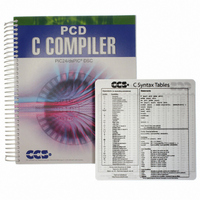PCDIDE COMPILER Custom Computer Services Inc (CCS), PCDIDE COMPILER Datasheet - Page 333

PCDIDE COMPILER
Manufacturer Part Number
PCDIDE COMPILER
Description
PCD C-COMPILER PIC24, DSPIC
Manufacturer
Custom Computer Services Inc (CCS)
Type
Compilerr
Datasheet
1.PCD_COMMAND_LINE_COMPILER.pdf
(373 pages)
Specifications of PCDIDE COMPILER
For Use With/related Products
Microchip PIC24/dsPIC®
Lead Free Status / RoHS Status
Not applicable / Not applicable
Other names
429-1008
- Current page: 333 of 373
- Download datasheet (4Mb)
Not enough RAM for all variables
The program requires more RAM than is available. The symbol map shows variables allocated.
The call tree shows the RAM used by each function. Additional RAM usage can be obtained by
breaking larger functions into smaller ones and splitting the RAM between them.
For example, a function A may perform a series of operations and have 20 local variables declared.
variables are not shared between the parts. A function B may be defined with 7 local variables and
a function C may be defined with 7 local variables. Function A now calls B and C and combines
the results and now may only need 6 variables. The savings are accomplished because B and C
are not executing at the same time and the same real memory locations will be used for their 6
variables (just not at the same time). The compiler will allocate only 13 locations for the group of
functions A, B, C where 20 were required before to perform the same operation.
Number of bits is out of range
For a count of bits, such as in a structure definition, this must be 1-8. For a bit number
specification, such as in the #BIT, the number must be 0-7.
Only integers are supported for this operation
Option invalid
Out of ROM, A segment or the program is too large
A function and all of the INLINE functions it calls must fit into one segment (a hardware code page).
function and that function is 600 instructions long, you will get this error even though the chip has
plenty of ROM left. The function needs to be split into at least two smaller functions. Even after
this is done, this error may occur since the new function may be only called once and the linker
might automatically INLINE it. This is easily determined by reviewing the call tree. If this error is
caused by too many functions being automatically INLINED by the linker, simply add a
#SEPARATE before a function to force the function to be SEPARATE. Separate functions can be
allocated on any page that has room. The best way to understand the cause of this error is to
review the call tree.
Parameters must be located in RAM
Parameters not permitted
An identifier that is not a function or preprocessor macro can not have a ' ( ' after it.
Pointers to bits are not permitted
Addresses cannot be created to bits. For example, &X is not permitted if X is a SHORT INT.
Previous identifier must be a pointer
A -> may only be used after a pointer to a structure. It cannot be used on a structure itself or other
kind of variable.
Upon analysis, it may be determined that there are two main parts to the calculations and many
For example, on the PIC16 chip a code page is 512 instructions. If a program has only one
319
Related parts for PCDIDE COMPILER
Image
Part Number
Description
Manufacturer
Datasheet
Request
R

Part Number:
Description:
PROTOTYPING BOARD FOR PIC MCU
Manufacturer:
Custom Computer Services Inc (CCS)

Part Number:
Description:
Extra CCS C Manual
Manufacturer:
Custom Computer Services Inc (CCS)

Part Number:
Description:
MACH X Programmer
Manufacturer:
Custom Computer Services Inc (CCS)

Part Number:
Description:
PCD For 24-bit (PIC24/dsPIC)
Manufacturer:
Custom Computer Services Inc (CCS)

Part Number:
Description:
LOAD-n-GO Programmer
Manufacturer:
Custom Computer Services Inc (CCS)

Part Number:
Description:
EMBEDDED INTERNET DEVELOPMENT KIT W/PCWH
Manufacturer:
Custom Computer Services Inc (CCS)

Part Number:
Description:
PIC24F Development Kit With PCWHD
Manufacturer:
Custom Computer Services Inc (CCS)

Part Number:
Description:
PIC24F Development Kit With PCDIDE
Manufacturer:
Custom Computer Services Inc (CCS)

Part Number:
Description:
PIC24H Development Kit With PCWHD
Manufacturer:
Custom Computer Services Inc (CCS)

Part Number:
Description:
USB Master Prototyping Board
Manufacturer:
Custom Computer Services Inc (CCS)










